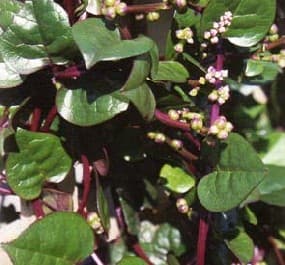How to Grow Malabar Climbing Spinach Flowers

About Growing Malabar Plants in Your Home Flower Garden
Looking for a climbing ornamental flower that is also edible!? Malabar Climbing Spinach plants are for you. This climber will reward you, growing vines up to 8-10 feet in a single season. As it grows, you can pick young, tender leaves for salads. The leaves have a pepper-lemon flavor. The plants are native to Africa, India and South to Southeast Asia. Use this guide to learn “How to Grow Malabar Flowers”. Then, plant some seeds and watch these vines, as they quickly climb up a trellis, post, or fence.
The plant has dark green leaves with burgundy vines and flower buds. Make sure to provide support for this plant to climb on. It will look great, climbing up a trellis or along a fence.
The plants produce small, white flowers, from summer into fall. The spent blooms will produce berries, in areas with a longer growing period.
Most gardeners will grow Malabar Climbing Spinach as an annual. In warmer weather, it can be grown as a perennial.
While Malabar Climbing Spinach is not a true spinach, it tastes great in salads, soups, and stir-fries.
Malabar Spinach Plant Specifications
Flower Colors: White
Flowers Bloom: 70 to 85 days after planting seeds.
Plant Height: Vines grow ten to fifteen feet long..
Ideal Soil pH: 5.5 – 8.0. However, it grows best in slightly acidic soils.
Light Requirement: Full sun.
Hardiness Zones: 7 – 10
Are Plants Toxic? No.
Deer Resistant? No. Deer and other foraging animals eat it.
Number of Species: Over 2 species.
Native To: Tropical regions in south and southeast Asia, the subcontinent of India.
Plant Type: Annual
Name: Basella Alba and Vasella Rubra
Other Names: Red Malabar Nightshade, Indian Spinach, Ceylon Spinach
Is Malabar Spinach Edible?
YES!!
This plant is a flower and a vegetable. As a vegetable, it is nutritious. It is high in calcium, iron, and vitamins A and C. You can eat it raw or cooked.
Use the leaves and stems in any salad or recipe. Begin to use the leaves as sone as the vines grow a few feet long, about fifty days. At first, pick the leaves lightly. The berries are high in antioxidants and are used in a variety of ways. The flowers and seeds are edible, too.
Note: Unripe berries may cause stomach ache or cramps. But otherwise, they are not harmful.
Malabar Spinach Medicinal Applications
In addition to the nutritional health benefits of eating Malabar Spinach, there are a wide variety of medicinal applications.
Among the medicinal uses are:
- It helps to fight cardiovascular disease.
- Chew on the raw leaves to treat mouth ulcers.
- The juice can help with diet control and weight loss.
- It helps to cool, purify, and rejuvenate blood.
- Juice from the leaves helps to clear phlegm from respiratory passages.
- Apply a paste to treat cracked heals.
- The roots are used to stop vomiting.
- It helps to prevent rectal and colon cancer.
Light Requirements
Like other vegetable plants, Malabar Spinach grows best in full sunlight. However, this cool weather plant benefits from a light partial afternoon shade in hot regions of the country.
A little light, partial shade in the summer makes the leaves sweeter and succulent.
Malabar Spinach Plant Propagation
Here’s how to grow Malabar Spinach plants from seeds:
For an early start, sow seeds indoors 4 to 6 weeks before the last frost. We recommend a heated germination mat, to increase the speed of germination, and for a higher germination rate.
Keep the soil moist, not wet, after planting.
Germination Tip: Soak seeds overnight, before planting.
Seeds can also be directly sowed outdoors after the last frost date for your area.
Planting Depth: 1/4″
Days to Germination: 10 – 15 days.
Final Plant Spacing: 10-12″ apart.
How to Grow Malabar Flower Plants
Select a growing location that is in full sun, and where there is a trellis or fence for the vines to climb. The plants will tolerate partial sun. It can be planted in a container and grown down from a deck.
While the plants like warm weather, choose an area with partial shade in hotter areas of the country.
The plants need rich, loose soil to help fuel growth. Mix in plenty of compost to the planting site. The soil should be able to retain water, but also be well-drained.
Plants grow best in warm, rainy climates. Keep the soil moist throughout the growing season. But, do not allow the soil to become soggy for extended periods.
Give plants a regular dose of fertilizer, every 3-4 weeks.
Mulch around plants to keep weeds down, and to retain soil moisture.
If your space, height, or width, is limited, trim back plants from time to time.
Also see: Plant Problems – Identify the causes and find the cures.
Insects and Plant Disease
Insect and disease problems are infrequent.
Importantly, if you are using Malabar’s edible leaves, avoid insecticides and fungicides.
Harvesting Malabar Leaves
You can begin to harvest leaves for the kitchen, as soon as the plant is established, and the vine is growing well.
Young, tender leaves have the best taste and texture.
Related Articles
Also, people who read this article will like:
Please support our site. Shop for:
- rmmatthews100@hotmail.com
- 585-721-6528
- Rochester, NY
©1999-2024 GardenersNet.Com, All Rights Reserved

